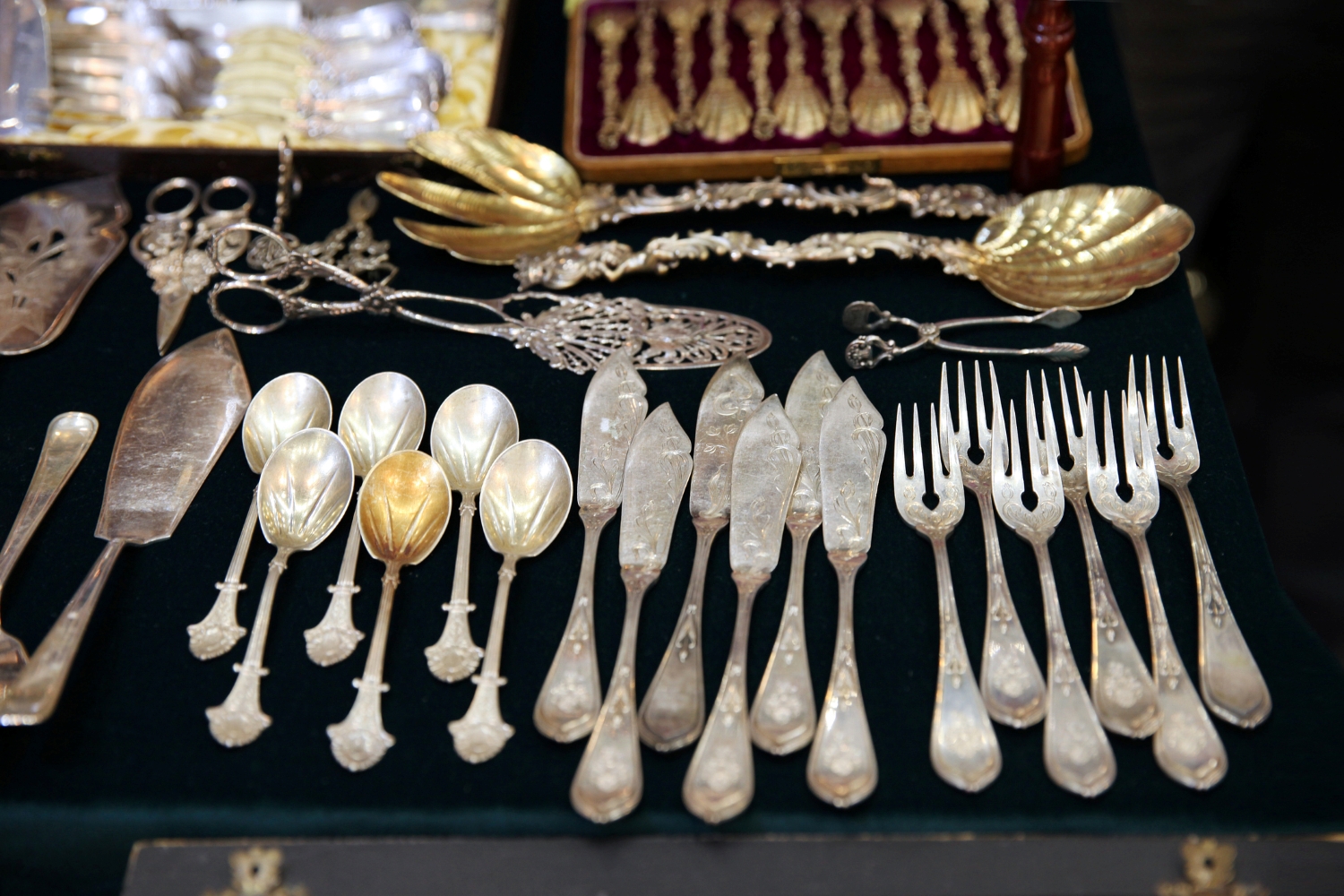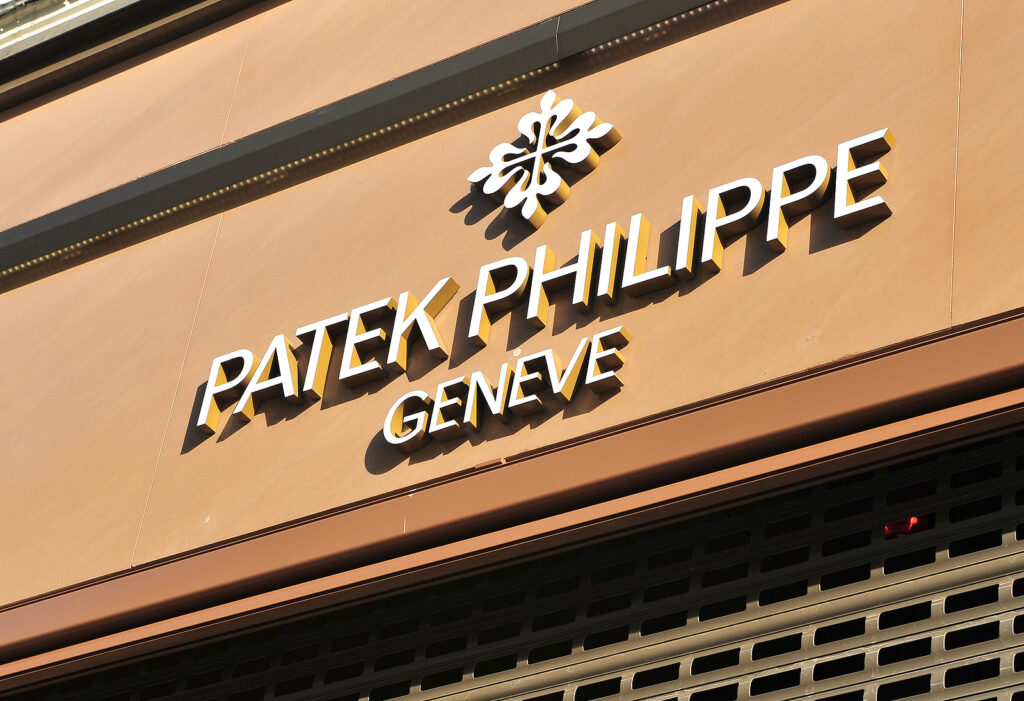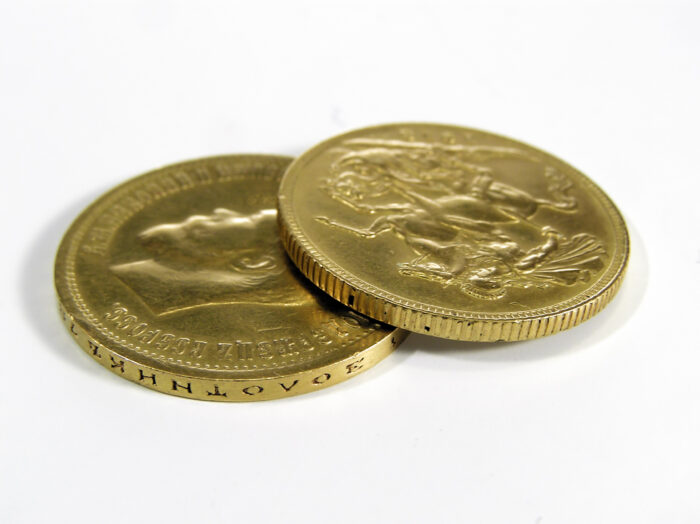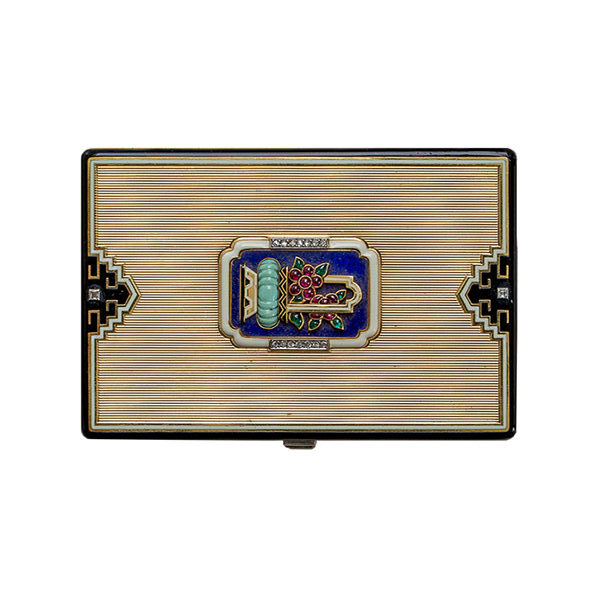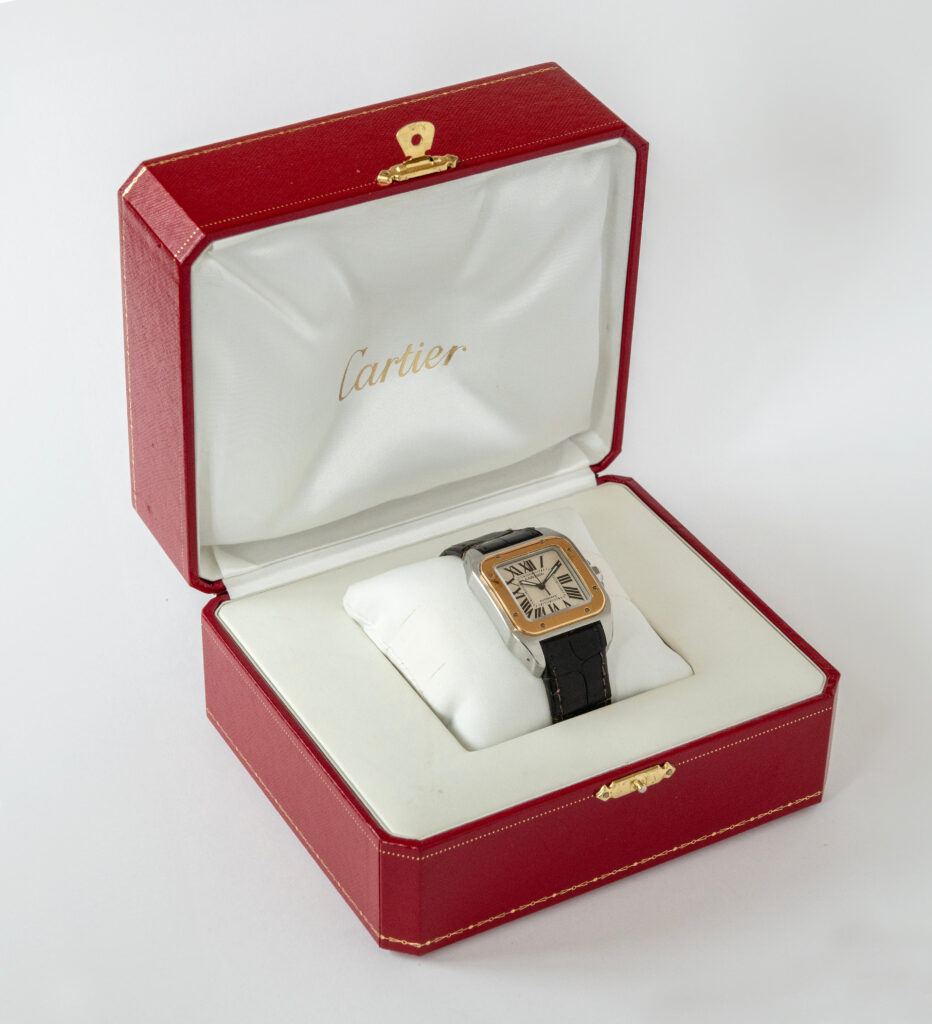Selling a silver cutlery set can be a rewarding experience, especially if you know how to prepare for the sale properly. Whether you’ve inherited a beautiful antique Victorian set, are downsizing a vintage collection, or simply wish to convert your old silver into cash, the steps you take before selling can make all the difference.
We pride ourselves on helping clients achieve a fair price for their silver. Here’s everything you need to do to ensure you’re ready for a successful sale.
Identifying a Silver Cutlery Set
Identifying what kind of silver you have is crucial for understanding its value. The first step is determining whether your cutlery is sterling silver or silver-plated:
Sterling Silver: This is 92.5% pure silver. Sterling is significantly more valuable than silver-plated due to its higher silver content. Its value is not just in its aesthetic but also in its precious metal content, making it a sought-after choice for collectors and investors alike.
Silver-Plated: Unlike sterling, silver-plated items are made of a base metal (such as copper or nickel) and coated with a thin layer of silver. These are much less valuable than sterling, often worth more for their craftsmanship or design rather than metal value. It’s important to be aware of this difference when setting expectations for sale prices.
We should note now, that Burlingtons Ltd. does not value or buy silver-plated items.
Look for Hallmarks
Hallmarks are crucial in identifying and verifying the authenticity of silver cutlery. These small stamps are usually found on the underside of forks, spoons, and knives. Key hallmarks to look for include:
- 925: Indicates the item is sterling silver with 92.5% purity.
- Lion Passant: A symbol used in British silver to signify sterling quality.
- Sterling: An American hallmark typically found on silverware produced after 1850.
- Maker’s Marks: These are unique stamps from the manufacturer. Recognised makers can add substantial value to the piece.
If you’re unsure about the hallmarks, a professional appraisal can help verify authenticity and estimate value.
Examine the Brand or Maker’s Mark
Certain brands are highly sought after by collectors due to their craftsmanship and historical significance. Brands such as Tiffany & Co., Gorham, Christofle, and Wallace are known for their high-quality materials and stunning designs. Sets from these makers can command premium prices, particularly if they are complete and in good condition.
Inspect for Pattern and Design
The design of your silver cutlery can significantly impact its value. Antique patterns, especially those that are discontinued or rare, are often more valuable than contemporary designs. Popular patterns include:
- Francis I by Reed & Barton
- Chantilly by Gorham
- Grand Baroque by Wallace
- Old Master by Towle
Collectors often seek out these patterns to complete their collections or restore antique sets.
Assess the Condition
Condition plays a major role in determining value. When inspecting your silver cutlery, look for:
- Tarnishing: While common, too much tarnish can affect visual appeal and market value.
- Dents and Bends: Damaged pieces are often worth less, although some collectors appreciate a patina that speaks to the item’s age.
- Monograms: While monograms can personalise an item, they may reduce its value to some buyers who prefer untouched pieces.
A well-preserved set, especially one with minimal wear and no monogram, is more likely to attract higher offers.
Research the Market Value
Understanding the current market value of your silver cutlery set is essential for setting realistic expectations.
Look Up Recent Sales
A great way to gauge the current market value of your silver cutlery is by examining recent sales. Check reputable online marketplaces like eBay, Etsy, and 1stDibs, where antique silverware is frequently bought and sold. Additionally, reviewing auction house results from platforms like Sotheby’s, Christie’s, and Bonhams can provide insight into high-end valuations.
Pay attention to the final sale prices for similar brands, patterns, and conditions to understand what collectors are currently willing to pay.
Consider Historical Value
Some silver cutlery sets hold historical significance that can dramatically influence their market value. Look for sets tied to specific historical events, limited-edition releases, or those created during notable design movements like Art Deco or Victorian Era. Pieces with provenance or documentation proving their age and history often command a premium due to their uniqueness and scarcity.
If your set is linked to a renowned silversmith or an influential era, this can significantly boost its appeal to collectors who seek authenticity and legacy in their purchases.
Analyse the Demand
Understanding the current demand for particular styles and designs is crucial. Popular styles such as Art Deco, Victorian, and Georgian are highly sought after due to their craftsmanship and timeless appeal. If you discover that your silver cutlery matches a design trend that is currently in demand, you may be able to secure a higher price during the sale.
Pay attention to collector forums, antique trade shows, and silver exhibitions to get a sense of market trends and what buyers are currently interested in acquiring.
How to Properly Clean and Preserve a Silver Cutlery Set
Properly cleaning and preserving your silver cutlery set is vital for maintaining its value and appeal.
Avoid Harsh Cleaners
Silver is a delicate metal that can be easily damaged by harsh chemicals. Always use gentle polishing cloths and products specifically designed for silver. Avoid abrasive materials and household cleaners, as these can scratch the surface or strip away its protective layer.
Instead, opt for a mild silver polish and a soft, lint-free cloth. For light tarnishing, a simple rub with a silver cleaning cloth is often enough. For heavier tarnish, use a reputable silver polish that is designed to clean without removing the metal itself.
Do Not Over-Polish
While it’s important to keep your silver clean, over-polishing can do more harm than good. Excessive polishing can remove the patina, the soft glow that forms over time and is often valued by collectors for its historical charm. Aim to clean only when necessary to maintain both its shine and its antique allure.
Store Properly
If you are waiting for the right time to sell, proper storage is crucial to prevent further tarnishing and damage. Store your silver cutlery in its box where this is possible, or anti-tarnish bags, or wrap each piece individually in acid-free tissue paper where it isn’t. Avoid damp or humid places, as moisture accelerates oxidation. For best results, keep them in a dry, dark place away from sunlight and fluctuating temperatures.
Gathering Documentation and Provenance
To maximise the value of your silver cutlery set, it’s important to gather any supporting documentation and establish its provenance.
Find Original Packaging or Boxes
If your silver cutlery set still has its original packaging or branded boxes, this can significantly enhance its value. Collectors appreciate the authenticity that comes with complete sets, and the original packaging adds a layer of assurance that the items are genuine and well-preserved.
Look for Purchase Receipts
Proof of purchase can be incredibly useful when selling your silver cutlery. Original receipts serve as verification of its history and can further validate its authenticity. If you still have these documents, make sure they are kept in good condition and presented during appraisals.
Research Family History
If your silver cutlery set has been passed down through generations, its history can be a selling point. Researching its origins and any significant family stories associated with the set can add a personal touch that appeals to collectors. Documenting these stories can help establish a connection and increase perceived value.
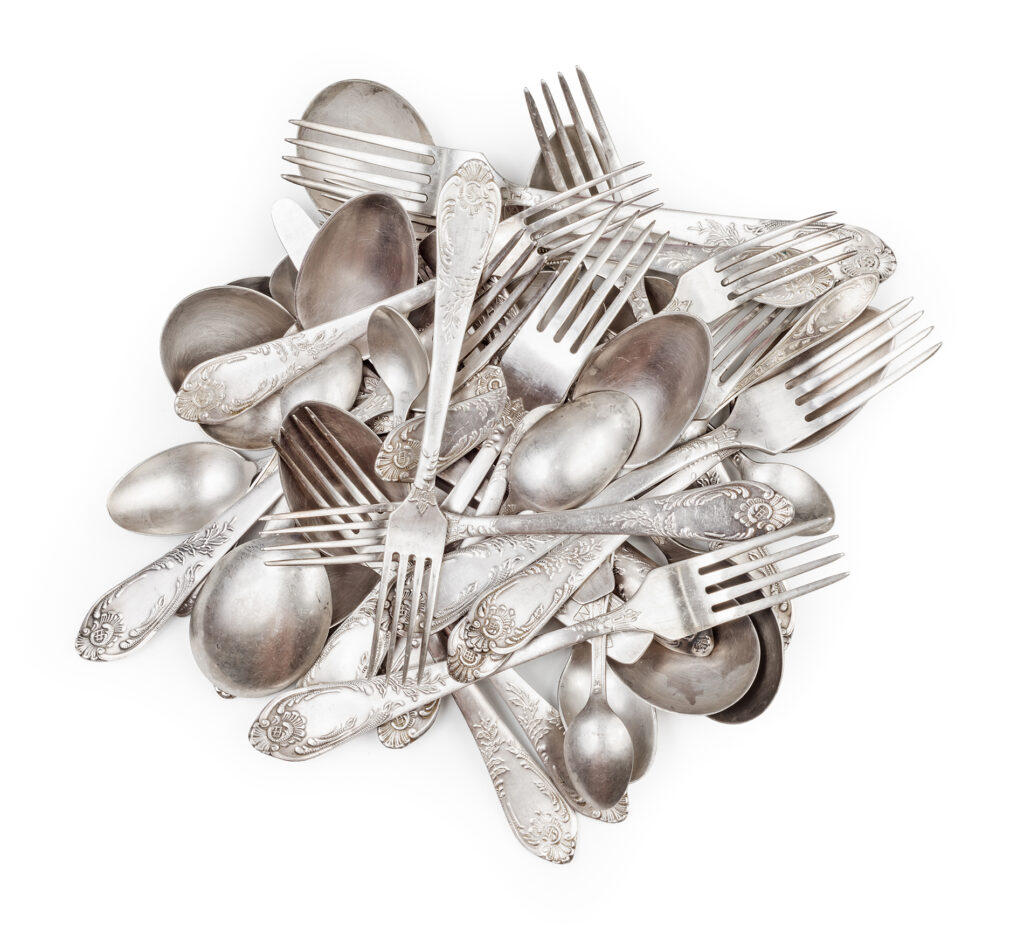
Getting a Professional Valuation or Appraisal
One of the most effective ways to establish the value of your silver cutlery set is through a professional appraisal. This ensures you have a clear understanding of its market value, authenticity, and condition, setting you up for realistic expectations when selling.
Choose a Reputable Expert
To ensure the accuracy of your valuation, choose a reputable expert who specialises in silver. You can ask for references or check their credentials online to verify their experience with antique, vintage, or old silver items.
If you’re unsure where to begin with this, don’t worry. Burlingtons Ltd. has years of experience in handling and valuing solid silver of all kinds. We’ll be happy to take you through a free, no-obligation valuation that allows you to make a fully informed decision before selling.
Deciding Where to Sell
Once you understand the value of your silver cutlery, the next important step is deciding where to sell it. Your choice of marketplace can significantly impact the final price you achieve and the smoothness of the transaction.
Direct Sale to a Trusted Buyer
Selling directly to a trusted buyer offers unmatched convenience and peace of mind. At Burlingtons Ltd., we provide a personal valuation service in the comfort of your own home, where your silver is assessed by experienced professionals. If you choose to sell, immediate payment is provided, with no waiting for auction dates or long sales processes. This method is ideal if you want a swift, discreet, and stress-free transaction.
Auction Houses
Auction houses can be an excellent choice if your silver cutlery set is particularly rare or holds significant historical value. High-end auction houses like Sotheby’s, Christie’s, and Bonhams regularly attract collectors willing to pay premium prices. However, it’s important to be mindful of the high fees associated with auctions. Additionally, there is often a waiting period before your item is featured in a sale.
Online Marketplaces
Online platforms and specialist antique websites allow you to reach a global audience. This can be advantageous for selling more common patterns or lightly used sets. However, sellers need to be vigilant, understand market prices and learn to avoid scams. Online platforms also come with their own fees and you are responsible for shipping and handling.
Antique Dealers
Antique dealers can provide quick, in-person transactions and valuable insights into your set’s worth. While dealers may offer slightly lower prices than auction houses or direct buyers to cover their profit margins, the sales process is typically straightforward and immediate. This is a good option if you want a fast sale without the wait and complexity of auctions.
Timing Your Sale
Selling your silver cutlery set at the right time can make a significant difference in the final price you achieve.
Seasonal Demand
Certain seasons and events naturally increase interest in silverware, particularly during the holiday season. As families prepare for festive gatherings, items like antique silver cutlery sets become more desirable, both for personal use and as thoughtful gifts.
Additionally, wedding seasons (typically spring and summer) may see a rise in demand for elegant silver pieces. If your cutlery set has a particularly ornate or vintage aesthetic, it could attract buyers looking to elevate their special occasions.
Market Trends
The value of silver can fluctuate significantly based on the global market. Factors like economic conditions, investment trends, and geopolitical events can affect silver prices, impacting the resale value of your cutlery set.
Keep an eye on the current market rate for silver and track historical data to understand trends. This is especially important if your set contains Sterling Silver (92.5% pure silver), as its value is closely tied to the spot price of silver as a commodity.
Understanding Legal and Tax Implications
When selling a silver cutlery set, it’s important to be aware of any legal and tax obligations that may apply. Understanding these requirements not only ensures a smooth transaction but also helps you avoid unexpected surprises after the sale.
Capital Gains Tax
In the UK, the sale of valuable items, including silver cutlery sets, may be subject to Capital Gains Tax (CGT) if the profit from the sale exceeds the annual tax-free allowance. This tax applies to the difference between the purchase price (or inherited value) and the sale price.
However, there are certain exemptions for personal chattels – tangible movable property with a lifespan of fewer than 50 years. If your silver cutlery is considered an antique or has significant historical value, it may not be classified as a personal chattel, making it subject to CGT. It’s advisable to consult with a tax advisor or legal professional to understand your specific obligations.
Obtain Receipts for Transactions
Documenting the sale of your silver cutlery is essential, especially if it is of high value. Always obtain a receipt for the transaction, detailing:
- Buyer and Seller Information: These are the names and contact details of both parties.
- Item Description: This is a detailed list of the items sold, including any hallmarks, maker’s marks, and condition notes.
- Sale Price: This is the agreed amount paid for the set.
- Date of Transaction: This is to establish the timeline for tax and legal purposes.
Get Everything You Need from Burlingtons Ltd.
When you’re ready to sell your silver cutlery set, consider the expertise and personalised service of Burlingtons Ltd. We offer instant payments, free, no-obligation home valuations, and a discreet selling experience tailored to your needs.
Our expert will be glad to take you through what makes your silver cutlery so valuable, before naming a fair but competitive market selling price. This will be based on current trends, as well as the prices offered by our extensive network of collectors. We may even have a potential buyer ready and waiting by the time we come to see your items.
Contact us today to schedule your valuation and take the first step toward a seamless, rewarding sale.
